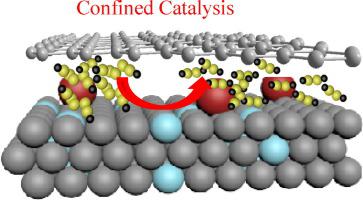Chemical Engineering Journal ( IF 13.3 ) Pub Date : 2020-10-14 , DOI: 10.1016/j.cej.2020.127323 Hongcheng Gao , Shunlian Ning , Yuan Zhou , Shuang Men , Xiongwu Kang

|
Slow redox kinetics of polysulfides (PSs) on sulfur cathode remains a grand challenge for achieving high rate, high capacity and long cycling performance of Li-S batteries, especially in lean electrolyte condition. Herein, we demonstrate the preparation of cobalt (Co) nanoparticles-decorated and nitrogen-doped carbon nanocages confined in a carbon shell (denoted Co-NC@C) through carbonization of polyacrylonitrile (PAN)-encapsulated ZIF-67 (ZIF-67@PAN) prepared by a simple “phase-inversion” method. The Co nanoparticles supported on nitrogen-doped carbon frame and confined in the carbon shell can efficiently promote the redox kinetics of PSs due to the confined catalysis, as demonstrated by density functional theory (DFT) calculation and electrochemical measurements. Therefore, the sulfur cathode based on such confined hollow core/shell nanocages delivers a capacity of 635.8 mAh g−1 at 5 C and an outstanding cycling stability with an ultralow capacity decay of 0.018% per cycle for 2700 cycles at 1 C. Furthermore, a reversible capacity of 552.9 mAh g−1 was delivered at a current density of 0.2 C over 500 cycles at a high sulfur loading of 5.7 mg cm−2 under lean electrolyte condition. Meanwhile, a high areal capacity of 9.5 mAh cm−2 was achieved at a sulfur loading of 10.2 mg cm−2. More intriguingly, a soft-packaged Li-S batteries based on this composite cathode material also exhibited superior cycling stability in folding conditions, demonstrating a high potential for practical application in wearable electronic devices.
中文翻译:

聚丙烯腈诱导的核-壳碳纳米笼的形成:通过Li-S电池中的受限催化,增强了对多硫化物的氧化还原动力学
在硫阴极上,多硫化物(PSs)的缓慢氧化还原动力学仍然是实现Li-S电池高倍率,高容量和长循环性能的巨大挑战,特别是在稀薄电解质条件下。本文中,我们演示了通过聚丙烯腈(PAN)包裹的ZIF-67(ZIF-67 @)碳化,制备限制在碳壳(表示为Co-NC @ C)中的钴(Co)纳米颗粒修饰和氮掺杂碳纳米笼的制备方法。 PAN)是通过简单的“相位反转”方法制备的。如密度泛函理论(DFT)计算和电化学测量所证明的那样,由于受限的催化作用,负载在氮掺杂碳框架上并被限制在碳壳中的Co纳米颗粒可以有效地促进PS的氧化还原动力学。因此,在5 C时为-1,并且具有出色的循环稳定性,在1 C下2700次循环具有每周期0.018%的超低容量衰减。此外,在500次循环中以0.2 C的电流密度提供了552.9 mAh g -1的可逆容量在贫电解质条件下,在5.7 mg cm -2的高硫负荷下。同时,9.5毫安厘米高面积容量-2 10.2毫克cm的硫负载达到-2。更有趣的是,基于这种复合正极材料的软包装Li-S电池在折叠条件下也表现出出色的循环稳定性,这表明了在可穿戴电子设备中实际应用的巨大潜力。











































 京公网安备 11010802027423号
京公网安备 11010802027423号